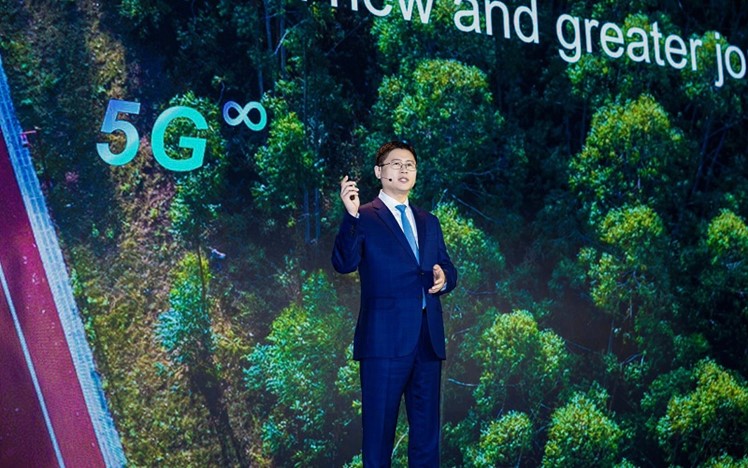
Written by: Izzat Najmi Abdullah, Journalist, AOPG.
The first day of the 14th Global Mobile Broadband Forum continued the keynote delivered by Li Peng, Huawei’s Corporate Senior Vice President and President of the Carrier Business Group (Carrier BG).
Li Peng began by emphasising the need for collective action in terms of moving 5G forward, saying, “Let’s start today, build tomorrow’s networks for future services, and unleash 5G’s infinite potential for continuous success.”

Li Peng, Corporate Senior Vice President, President of the Carrier BG, Huawei
In his speech, Li expounded on the concept of powering a positive 5G business cycle and embracing 5.5G (also commonly referred to as 5G-A). He also pointed out that the world is already “on the right path towards 5G business success, and that 5G-Advanced is the next big step in 5G’s evolution.”
Historically, major economic transformations have sprung from innovation in general-purpose technologies. As the world drives further into the digital age, Li emphasises the pivotal role of the internet in driving the digital economy, saying, “5G is a critical part of new economic transformation and it’s enabling new innovation in general-purpose technologies. For digital industries, 5G is developing fast, opening up new markets and opportunities.”
Li then outlined six key features essential for future mobile networks:
- 10 Gbps downlink.
- 1 Gbps uplink.
- Deterministic networking.
- Support for a hundred-billion Internet of Things (IoT) connections.
- Integrated sensing and communication.
- Native Artificial Intelligence (AI) capabilities.
Achieving these milestones, in turn, demands the continuous enhancement of 5G capabilities in three core usage scenarios—enhanced Mobile Broadband (eMBB), massive Machine-Type Communications (mMTC), and Ultra-Reliable Low-Latency Communication (URLLC)—along with the development of two new capabilities, namely Uplink Centric Broadband Communication (UCBC) and Real-Time Broadband Communication (RTBC).
Additionally, Li highlighted the significance of cooperation in promoting the development of device and application ecosystems, validating use case scenarios, and accelerating the large-scale commercialisation of Fixed Wireless Access (FWA) Square, Passive IoT, and RedCap.
The Huawei executive then explained that recognising and acting on five key trends will help harness the opportunities presented by these technological advancements. The key trends that Li believes will shape the future of connectivity are as follows:
- Glasses-Free 3D. The glasses-free 3D industry is advancing rapidly, driven by breakthroughs in cloud rendering and real-time 3D virtual humans. This progress will elevate the immersive experience to new heights, with more devices, including mobile phones and TVs, supporting glasses-free 3D, resulting in a tenfold increase in data traffic compared to 2D video.
- Self-Guided Vehicles. The proliferation of smart vehicles is expected to exceed 500 million by 2025. High-bandwidth and low-latency networks will enable these vehicles to share real-time information with people, other vehicles, roads, and the cloud. In assisted-driving scenarios, smart vehicles will consume over 300 gigabytes of data each month for cloud-based model training and algorithm updates. In self-driving scenarios, data consumption is anticipated to increase a hundredfold.
- Next-Gen Manufacturing: Network slicing and edge computing have led to a hundredfold increase in the number of 5G private networks for enterprise use, with a market size exceeding USD $10 billion. As production lines become more reliant on wireless networks and core production systems move to the cloud, the demand for robust 5G networks is escalating. Huawei’s collaboration with industry partners has resulted in the development of the first 5G-Advanced flexible trial production line, ensuring high-concurrency and highly deterministic network connections to facilitate efficient computing power connectivity between the cloud and network edge.
- Generalised Cellular IoT. The global mobile IoT connections have surpassed three billion, with 5G connecting more things than people. In the near future, 5G will support a broader range of IoT technologies, such as medium-speed RedCap and Passive IoT, enabling more efficient data flow and increasing productivity across various sectors, including home appliance manufacturing.
- Guaranteed Intelligent Computing Everywhere. With the rapid advancements in AI, the demand for AI computing power is expected to grow 100 times greater by 2025. Future networks will require larger bandwidth and lower latency to support truly intelligent connectivity. As traffic models evolve, networks must become more autonomous and intelligent to deliver a reliable experience.
Huawei has put its cards on the table for the next step in the future of connectivity with its 5.5G initiatives. Now, it is up to the other 5G and 5.5G stakeholders to step up and ensure that the global telecommunications landscape evolves to meet the rising demands of an increasingly connected world.
The world craves speed, but who is brave enough to deliver?
 (0)
(0) (0)
(0)Archive
- October 2024(44)
- September 2024(94)
- August 2024(100)
- July 2024(99)
- June 2024(126)
- May 2024(155)
- April 2024(123)
- March 2024(112)
- February 2024(109)
- January 2024(95)
- December 2023(56)
- November 2023(86)
- October 2023(97)
- September 2023(89)
- August 2023(101)
- July 2023(104)
- June 2023(113)
- May 2023(103)
- April 2023(93)
- March 2023(129)
- February 2023(77)
- January 2023(91)
- December 2022(90)
- November 2022(125)
- October 2022(117)
- September 2022(137)
- August 2022(119)
- July 2022(99)
- June 2022(128)
- May 2022(112)
- April 2022(108)
- March 2022(121)
- February 2022(93)
- January 2022(110)
- December 2021(92)
- November 2021(107)
- October 2021(101)
- September 2021(81)
- August 2021(74)
- July 2021(78)
- June 2021(92)
- May 2021(67)
- April 2021(79)
- March 2021(79)
- February 2021(58)
- January 2021(55)
- December 2020(56)
- November 2020(59)
- October 2020(78)
- September 2020(72)
- August 2020(64)
- July 2020(71)
- June 2020(74)
- May 2020(50)
- April 2020(71)
- March 2020(71)
- February 2020(58)
- January 2020(62)
- December 2019(57)
- November 2019(64)
- October 2019(25)
- September 2019(24)
- August 2019(14)
- July 2019(23)
- June 2019(54)
- May 2019(82)
- April 2019(76)
- March 2019(71)
- February 2019(67)
- January 2019(75)
- December 2018(44)
- November 2018(47)
- October 2018(74)
- September 2018(54)
- August 2018(61)
- July 2018(72)
- June 2018(62)
- May 2018(62)
- April 2018(73)
- March 2018(76)
- February 2018(8)
- January 2018(7)
- December 2017(6)
- November 2017(8)
- October 2017(3)
- September 2017(4)
- August 2017(4)
- July 2017(2)
- June 2017(5)
- May 2017(6)
- April 2017(11)
- March 2017(8)
- February 2017(16)
- January 2017(10)
- December 2016(12)
- November 2016(20)
- October 2016(7)
- September 2016(102)
- August 2016(168)
- July 2016(141)
- June 2016(149)
- May 2016(117)
- April 2016(59)
- March 2016(85)
- February 2016(153)
- December 2015(150)
